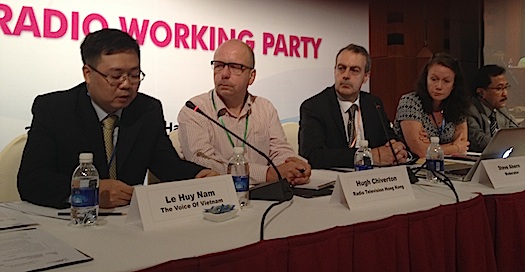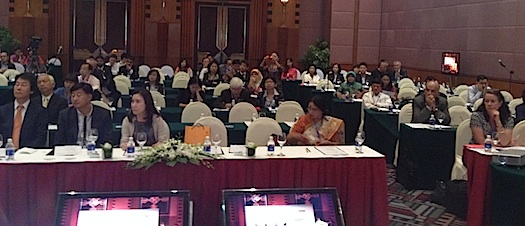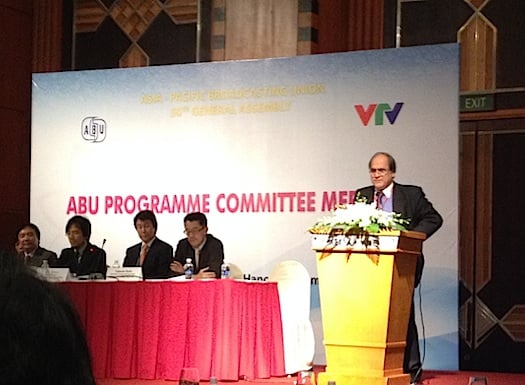The Asia Pacific Broadcasting Union’s general assembly in Hanoi has heard that radio is reinventing itself in the face of exciting but frightening challenges.
A debate in the Radio Working Party session today tackled the proposition that radio is still the ‘Captain of the Airwaves.’
Supporting the Yes case, RTHK’s Hugh Chiverton told a packed hall that radio is everywhere but “it is print that is declining.” There are tens of thousands of radio stations people still want to consume entertainment and information in an audio form, he said.
Voice of Vietnam’s Le Huy Nam supported Chiverton, giving examples from Vietnam, where radio reaches more than 99% of the population. While VoV has also progressed into multi-media outputs, radio is still so important.
Opposing the proposition was ABC’s Deborah Steele, who said the broadcast airwaves “are not as relevant as they used to be. The radio market has peaked, there’s only one way to go and that’s down,” she said, fighting her pro-radio instincts for the sake of the debate. People want to witness big events through still pictures and video according to Steele, who drew on the multimedia experience of the ABC for evidence that pictures draw a strong audience online. “In the Pacific, radio is still king, but in Asia and Australia that is no longer the case, the audience wants more,” she said.
Kabul Budiono from Radio Republik Indonesia was also on the negative team, saying that in such a big country as Indonesia, where 80% of the population lives in rural areas, radio is still important but that consumption patterns are changing rapidly. “The question is how to encourage people to keep listening to the radio as technology changes,” he said.

The debate, moderated by chairman Steve Ahern, also heard examples from the floor of where radio is embracing new technology and surviving. In Norway digital radio has revitalised radio consumption, but in parts of Europe, “when you talk about digital radio people assume you mean the internet,” said one speaker.
In India, where All India Radio is now competing against more than 300 new commercial stations, the enthusiasm for radio has increased as a result of competition, and in Fiji television is growing but radio is still king.
Ahern, who travels the world training in both broadcasting and new media skills, said the contrasts are wide across the various countries in the Asia Pacific region, and the changes that are happening are both ‘frightening and exciting.’ “Where there is confidence in the medium and broadcasters are upgrading their skills to widen the way they interact with their audiences, then radio remains relevant and successful.”
After the debate, a series of presentations looked at successes in radio across the region:
Norihito Saito, a Senior Producer at NHK Japan described the importance of NHK Radio’s role in delivering safety information to save lives. He also said that life saving information is migrating to the internet, because there is more searchability on the internet, so people can find the information more easily. In emergency broadcasting, contingency planning and using language carefully are two important points to remember according to Mr Saito.
Ruxandra Obreja, President of Digital Radio Mondiale discussed the interplay between hardward and software in digital radio and the importance of radio in emergencies.
“Get to know the functionality that digital radio can give you and promote it to your audience.” But technology is nothing without the right production and content according to Obreja. “We need to sell radio again, we must market the new features of digital radio to listeners and to governments. We must plan and commission interesting ‘software’ (in other words program content) so that listeners have plenty of interesting things to listen to,” she said.
Xia Jixuan, Vice-President of China Radio International talked about CRI’s use of what it calls ‘micro-films.’ These are short videos that support radio with multi media content and are an example of tapping potential in new media technology and content.
Behrouz Razavinejad, a Senior Advisor at IRIB, Iran said radio is an important part of Iran’s culture. He showed examples of where IRIB is upgrading its radio output to connect more closely with listeners and helping them by using radio to raise funds for charity.
Kabul Budiono, Director of Programmes and Production at RRI talked about one program which aims to enhance national identity and cultural diversity with new radio programs and multimedia output. RRI has 81 stations across Indonesia. The RRI program called ‘Rainbow’ promotes arts and culture from different regions, to promote peace and harmony amongst the many diverse cultures of Indonesia.
In two video messages Commercial Radio Australia’s Joan Warner presented the case study of how Australia has successfully launched digital radio, and Radio New Zealand’s Paul Bushnell discussed RNZ’s strategies to engage young listeners on new platforms and the importance of radio role as a reassuring friend in times of natural disasters.
In the discussion session that followed, All India Radio reminded delegates that radio networks in most countries hold important archival recordings that go far back before television. “Those are a rich cultural asset to radio and to the country.”
During the morning the ABU’s Vijay Sadhu outlined the range of activities undertaken by the ABU’s Radio team during the past year, including:
- ABU Workshop on Children Programming Formats – Malaysia
- ABU Workshop on Mobile Journalism – Indonesia
- In-Country Workshops on Content Creation: Thailand, Indonesia, China
- RadioAsia2013 Conference, Hanoi
- ABU DBS Symposium: Radio Session on New Media – Malaysia
- Plus progress on the World Summit on Media for Children next year and the ABU Radio Song Festival.
As a result of the Children’s Programming Workshop, a proposal has been put to the ABU to create an Asia Pacific Children’s Podcast Channel. The general assembly will decide whether to accept this proposal as the assembly continues in coming days.



Hi,
We think that radio is the best form of media available,you can listen to all different things on radio including music,audio books.However radio can be used for bad things like "Sexy Hour" on Loveland digital radio station.I think that radio should be more like Smooth FM and be positive and play good clean music with no swearing or sexy music.
From Jono and Ben and Sydney